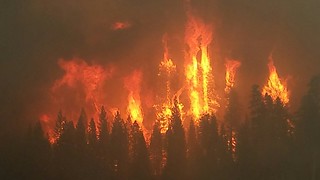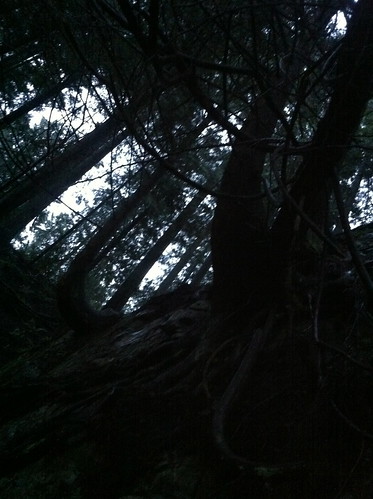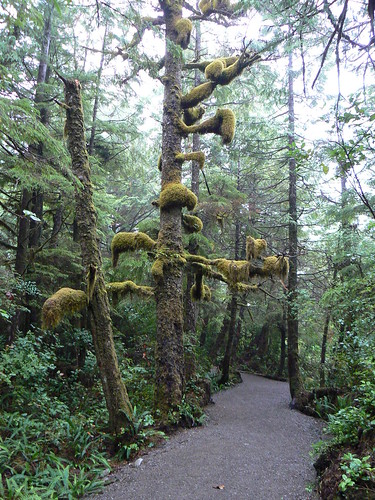Wildfires
Life Is A Struggle
- Herman Hesse, Bäume: Betrachtungen und Gedichte [Trees: Reflections and Poems]
If your sense of belonging does not come easy, trailing alongside the trees gives a great lesson and a sense of proportion. A single tree in the rainforests provides oxygen supplies for a year for ten people - in only one season of its existence (Arbor Day Foundation).
"On average, one tree produces nearly 260 pounds of oxygen each year. Two mature trees can provide enough oxygen for a family of four" (Environment Canada).
As I walk by these ancient creatures of wisdom who've breathed the planet's toxins, listened to the every bird's song, and exhaled serenity and purified air for hundreds if not thousands of years --
I'm awed not only by their stature, but also by what they have silently witnessed, and above all - to their dedication to light and life.
Tutored as the "green lungs" of our blue planet, we owe 28% of the oxygen we breathe to the rainforests and the trees. It is no wonder that trees have been sacred not only to the native Indians but even in more deserted climates such as the Middle East. There are trees who are worshipped, to this day, with colorful ribbons tied to their branches by pilgrims of religions long gone. It seems increasingly logical to make all trees sacred. Planting trees should become a common practice from young age...
There are 3 main trees in our beautiful Pacific Northwest forests: Douglas Fir (Pseudotsuga), Pacific Red Cedar (Thuja plicata) and Western Hemlock (Tsuga) and Sitka Spruce (Picea sitchensis). I'm still learning how to differentiate between them: they are all so big and often times their needles are so far out of reach that there is no way of examining their needles and comparing their shapes. And then the trees are young it's the opposite problem: you can see the needles, but the trunks are still quite similar in appearance (at least to my untrained eye). These amazing trees can live several hundreds and even well over 1,000 years!
So, as I struggle to find courage, motivation or inspiration between my 4 walls - I step out to my "back yard", breathe deeply - and try to listen to the trees.
Mossy Whale
The moss sculpts its way on the tree trunks and branches along the Wild Pacific Trail. And I’ve heard it has something to do with how crisp and clean the air is there… The mosses and lichen love it and adorn the trees with their moss-green velvety ropes and silvery laces… And nearby, whales spit a mist of water from their lungs which towers abaove the water and they weave in and out of its depths along the rocky shores.
I wanted to play on these themes of moss and marine creatures in the 4th mod. As it turns out, I went a little too far though… I was a little adventurous, and rather than adjusting the formula a bit by changing only an element or two, I added many different elements and nuances.
First, I wanted to see what happens if I add some more violety notes, so I added even omre cassie absolute, which has a wet-wood and leather quality to it and also boronia absolute, which I find to have a certain oceanic quality about it that is hard to explain, but if you smell it you will understand what I’m talking about. And added even more Haitian vetiver!
Remembering the rotting squids also made me want to add something animalic and marine to the mix – and that’s when the ambergris joined the game. My original concept of making this a simple and not crazy expensive perfume (except for the seaweed, which is essential) pretty much flew out of the window right that moment.
I should have probably stopper right than and there to see what transpires of my efforts. But I was unhappy of whatever result was going, and added a little more of this and that – which included more citrus (lime) and more woodsy notes (juniper, cypress). But where everything went out of control was when I decided to go with nothing else but cherry cedar, which is distilled locally, and I thought would be very appropriate for this British Columbian theme. What I added accounts for just about 2% of the formula was clearly too much. All I could notice now was cedar, cedar, cedar… Red, local, whatever…! It was too much.
I let it rest for just one week. I came back to it yesterday, and the thing has transformed into the craziest berry-cedar perfume I’ve ever smelled in my life. And than it turns interestingly salty with the seaweed and boronia and the moss. It’s not bad at all. But it’s not Orcas yet - unless you are imagining a killer whale that picks wild berries and carves canoes from cherry cedar.




